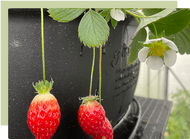Posted by Kelly Jean Reyland
6th Aug 2024
Growing strawberries at home
A firm family favourite, strawberries are easy to grow and don’t take up much room. Why pay high prices at the supermarket when you can enjoy your own home-grown sun ripened berries at home all summer long?
Pick a spot that is full sun and has good drainage. A large pot is a good option but remember to water it regularly!
When it comes to choosing varieties, older varieties such as Camarosa and Pajaro are ‘short day’, meaning they need a certain number of daylight hours to initiate fruiting. This meant fruiting occurs for a limited period, usually around November - December. Many modern varieties (Albion, Seascape etc) are day-length neutral and fruit over a longer period. Essentially, if temperatures are high enough for fruit to ripen, they will fruit. It is a good idea to plant a combination of both types to get as long a harvest as possible.
Strawberries hit peak production at about 3 years old and after that fruiting starts to lessen. Ideally you will have a replacement strategy where you plant younger plants in the 3rd year to replace the older plants and keep fruiting at maximum output. You can do this by buying new plants or potting up runners off the existing plants. Runners are little leaflets that are attached to the main plant by a longer than normal stem. If you pin the leaflet to the ground while it is still attached to the plant, it will form roots at which point you can cut the stem to the mother plant leaving you with a new plant. Runners are a great budget friendly way to increase your number of plants but try and swap some with a friend to ensure some genetic diversity in your plants.
If you want to ensure plenty of fruit to enjoy each summer, plant 5 (or more!) plants per person in your household.

Producing fruit takes up a lot of energy so make sure that you feed your strawberries with a berry fertiliser at planting time and side dress several times during the growing season. Give them an energy boost regularly while they’re producing berries with a liquid fertiliser that has a high ‘K’ number in the NPK rating on the bottle. ‘K’ is potassium which supports flower and fruit development. Do this every 7-14 days for lots of big, juicy, sweet fruit.
Protect your crop! Cover them with bird netting, pin the edges down securely and make sure there are no gaps or they’ll find a way in, or a Net Tunnel or cloche! Make sure you have some cloche hoops or stakes to ensure the birds can’t bounce on the netting and reach the berries through the netting. Trust me – they are clever and determined!
When watering, try and water the soil as gently as possible and avoid getting it on the leaves if possible. Water on the leaves increases humidity which creates perfect conditions for fungal diseases to thrive. A weeper hose is a good option to use. If possible, in the garden, plant them up on a mound to ensure good drainage and surround the plants with some pea straw or other mulch to keep the soil moisture in and to keep the berries out of contact with the soil.
Give them a preventative spray with a copper spray a few times through spring when humidity is higher to help prevent any fungal diseases getting established.
Plant your own strawberries and enjoy the flavour of sun ripened, delicious, sweet berries. It's a great way to get kids and grandkids involved the garden, picking and eating them!
Written for Gubba by Kelly Jean Reyland from Garden Advice NZ (www.gardenadvice.co.nz)


























